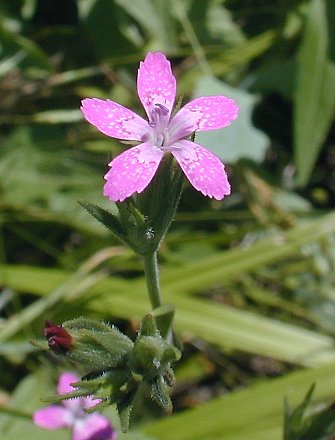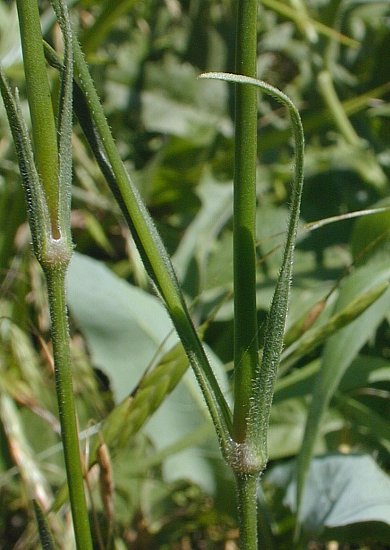Description: This annual or biennial plant is about 1-2½' tall and very slender in appearance. It branches sparingly above the widely spaced pairs of leaves. The stems are slender, round, and stiff. They have patches of fine white hairs beneath each opposite pair of leaves, otherwise they are mostly glabrous. The opposite leaves are up to 3" long and 1/8" (3 mm.) across. They are linear (although wider at the base), sessile, and usually slightly pubescent. The base of each pair of leaves wraps around the stem in a sheath, where the stem is somewhat broader and knobby. The upper stems terminate in small clusters of pink flowers. The flowering stalks (peduncles) are more hairy than the stems, otherwise they are similar in appearance. Each flower is about 1/3" (8 mm.) across, consisting of 5 spreading petals, a tubular green calyx with 5 teeth, 10 stamens with pink anthers, and 2 styles. The petals are pink with small white dots. Each petal is wedge-shaped at its base, and crenate or dentate toward its outer edge. The pubescent calyx is about ¾" long. It has about 10-22 fine nerves running along its length. There are usually 3 narrow leaf-like bracts that are about as long as the calyx at the base of the flower. Each cluster of flowers and bracts often have V-shape. Each flower is replaced by an elongated seed capsule containing numerous seeds. Each seed is orbicular or reniform and flattened with small bumps across its surface. The root system consists of a slender taproot. This plant spreads by reseeding itself.

Cultivation:
This
species usually grows in full sunlight in mesic to dry conditions. It
appears to flourish in a clay-loam or gravelly soil that is somewhat
compacted and heavy.
Range & Habitat:
The non-native Deptford Pink is fairly common in Illinois, except for
some central
and NW areas of the state, where it is rare or absent (see Distribution
Map). This species is adventive from Europe and it is
becoming
more common in disturbed areas. Habitats include pastures, abandoned
fields, areas along roadsides and railroads, paths along the edge of
woodlands that are irregularly mowed, grassy meadows with a history of
disturbance, and miscellaneous waste areas. This species declines in
high quality habitats because it isn't competitive with many
broad-leaved perennial forbs.
Faunal Associations:
The nectar of the flowers likely attracts small butterflies, skippers,
long-tongued bees, and bee flies. This is implied by the long tubular
calyx and the restricted opening at the throat of the flower, although
I have not seen very many insects visiting the flowers. Short-tongued
bees may collect the pollen, while flower flies undoubtedly feed on the
pollen – the latter group of insects is unlikely to be effective at
pollination. The foliage of members of the Pink family tends to be high
in saponins and unattractive to mammalian herbivores. In pastures,
livestock probably eat this insubstantial species along with the
surrounding grass.

Photographic
Location:
A weedy meadow at Judge Webber Park in Urbana, Illinois.
Comments:
The Deptford Pink has attractive flowers, but they are quite small.
This plant is easy to overlook until it begins blooming. The Deptford
Pink is fairly easy to identify in the field because of the appearance
of the flower petals: they are usually more narrow than the petals of
other Dianthus spp., their outer edges are toothed,
and they have small white dots across the surface. The flowers of this
species are smaller in size and less showy than the flowers of Dianthus
spp. (Pinks) that are commonly cultivated in flower gardens.
The common name refers to an area of England where this species was
once common.